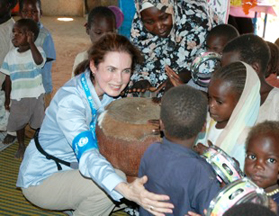
When I attended and live-blogged the 2012 Women in the World summit, I was surprised to find that Tweets from the handle of @dayleythought belonged to top model of the 1970s and 80s, Dayle Haddon. Ever the curious reporter, I did a quick search to find out what she was up to. I found the story of a personal evolution that is becoming more normative -- as women pioneer new ways to self-define and grow.
Haddon was the brunette that broke through the blonde barricades when Cheryl Tiegs reigned as icon of the "All American" look. Hailing from Canada, Haddon's background in ballet led to modeling and acting. One of her top roles included Nick Nolte's girlfriend in North Dallas Forty, a look at the underside of professional football.
Becoming a mother in her 20s, Haddon was 38 years old when her husband died unexpectedly. She was left without an economic base or source of income. She went back to the world of fashion and beauty, and was succinctly told that she was "over the hill." Haddon's instinctive reaction was, "That's not true."
About her experience of that time Haddon told me, "It was climbing up glass walls. My industry didn't want me, so I worked as a receptionist. I had to take care of my daughter." She noted that going from cover girl to office worker was "humbling," but that "it was a good thing." She was the "lowest person on the totem pole" and Haddon acknowledged, "No one made any fuss over me." It was a difficult period, but Haddon suggested that the experience was a "character builder."
Exasperated that the trade where she had previously made her living was writing off a whole demographic of women, Haddon believed that she could make a difference by encouraging the decision-makers to see otherwise. She pitched Max Factor and Revlon in the 90s on the concept of illustrating how attractiveness evolves. She represented Estée Lauder as the face of their new anti-aging line. When her contract with them expired, she immediately created a relationship with L'Oréal, and has been their spokeswoman for the Age Perfect skin care line for fifteen years.
Back in the game, she developed Dayle Haddon Concepts, became a contributor to CBS's The Early Show, and wrote two books on "ageless living for women 40 and over." In them, Haddon addressed physical appearance, health, emotional well-being, relationships, and community -- a topic that would prove to be a major interest for her.
Determined to open a conversation on defining beauty differently, Haddon's question was, "What are the components of beauty?" She emphasized that new elements had to be "brought into the equation." For Haddon, who had been raised in a family with a strong social consciousness, part of the progression included "giving back" and using her fame quotient to promote human rights issues, particularly as they impacted girls and women.
Social justice and activism are integral to Haddon's current pursuits. When I spoke with her by telephone, she had just returned from a trip to Haiti as a United States Fund for UNICEF Ambassador. The goal of her trip was to learn about initiatives for children in the realm of education, nutrition, and protection.
Haddon told stories about the extensive traveling she has done on fact-finding missions. Inspired by the reporting of columnist Nicholas Kristof, she lobbied Caryl Stern of UNICEF to assign her to a Darfur visit. A physically difficult journey, Haddon found speaking with women in the IDP camps "heartbreaking but inspiring." She then visited Angola to observe the actions being taken around HIV/AIDS and cholera. Haddon traveled to Rwanda and Congo on behalf of Raise Hope for the Congo, a project of Enough--which "fights genocide and crimes against humanity." The article she wrote about a teenage Congolese rape victim for the CNN website received over one million hits.
In conjunction with her efforts on behalf of Artbound and Free the Children in Kenya, Haddon learned about the need for funding girls' education. She stepped up to pay the tuition for 41 students, underwriting their four years of high school in Masai Mara. "I like uniting with other women to see how projects can converge and overlap," Haddon said. Wanting to develop a granular approach to larger concerns, Haddon founded WomenOne in 2009. The goal is to work in tandem with on the ground organizations in locales that are affected by violence, poverty, and civil war -- specifically with a focus on women and children.
Describing herself as a "logical person," Haddon is constantly pushing forward. She is not enmeshed in "looking back at what was good." She advised that if you wrap everything up in your appearance, "you will always be disappointed." Rather, she suggested, "Your value on yourself changes. When you follow your interests, things balance out."
Haddon also stressed the importance of developing an "inner life." A woman who enjoys "dressing up" but who can "still climb a cliff," Haddon continues to search for the equilibrium that suits her -- between work, family, and social engagement. "That changes all the time," she said. Expressing bafflement about those preoccupied with their younger years, Haddon asked rhetorically, "Why are we going to struggle to go backwards?"
As a grandmother and the mother of a 41-year-old daughter, Haddon said, "It's time to give back. It makes me feel young and beautiful." With WomanOne targeting specific endeavors and helping girls and women "one by one," Haddon's goal is to effect change. She reiterated that communicating to other women has always been "a thread" woven through her activities. Beyond helping women to feel good about themselves, Haddon said that she has consistently tried to find the "value" in things. Now, this includes making sure that those who have a voice are using it to help empower others in extreme circumstances.
Haddon brings renewed meaning to the adage, "Beauty is as beauty does."

Photo: David Forbes for UNICEF
This article originally appeared on the women's health site EmpowHER.
